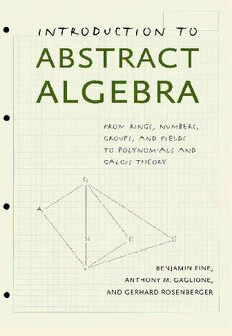
Introduction to Abstract Algebra: From Rings, Numbers, Groups, and Fields to Polynomials and Galois Theory PDF
Preview Introduction to Abstract Algebra: From Rings, Numbers, Groups, and Fields to Polynomials and Galois Theory
Introduction to Abstract Algebra This page intentionally left blank Introduction to Abstract Algebra From Rings, Numbers, Groups, and Fields to Polynomials and Galois Theory BENJAMIN FINE ANTHONY M. GAGLIONE GERHARD ROSENBERGER Johns Hopkins University Press Baltimore (cid:2)c 2014 Johns Hopkins University Press All rights reserved. Published 2014 Printed in the United States of America on acid-free paper 9 8 7 6 5 4 3 2 1 Johns Hopkins University Press 2715 North Charles Street Baltimore, Maryland 21218-4363 ISBN 13: 978-1-4214-1176-7 ISBN 10: 1-4214-1176-8 Library of Congress Control Number: 2013937859 A catalog record for this book is available from the British Library Special discounts are available for bulk purchases of this book. For more information, please contact Special Sales at 410-516-6936 or special [email protected]. Johns Hopkins University Press uses environmentally friendly book materials, including recycled text paper that is composed of at least 30 percent post-consumer waste, whenever possible. To the memory of Linda and Justin AMG To Linda, Carolyn, David, Scott, Jennifer, Shane, Sawyer, Quinn, Summer, Stratton BF To Katariina, Anja, Aila GR This page intentionally left blank Contents Preface xiii 1 Abstract Algebra and Algebraic Reasoning 1 1.1 Abstract Algebra 1 1.2 Algebraic Structures 2 1.3 The Algebraic Method 3 1.4 The Standard Number Systems 4 1.5 The Integers and Induction 6 1.6 Exercises 10 2 Algebraic Preliminaries 13 2.1 Sets and Set Theory 13 2.1.1 Set Operations 14 2.2 Functions 18 2.3 Equivalence Relations and Factor Sets 21 2.4 Sizes of Sets 25 2.5 Binary Operations 31 2.5.1 The Algebra of Sets 34 2.6 Algebraic Structures and Isomorphisms 36 2.7 Groups 37 2.8 Exercises 41 3 Rings and the Integers 51 3.1 Rings and the Ring of Integers 51 3.2 Some Basic Properties of Rings and Subrings 53 3.3 Examples of Rings 58 3.3.1 The Modular Rings: The Integers Modulo n 59 3.3.2 Noncommutative Rings 63 viii Contents 3.3.3 Rings Without Identities 64 3.3.4 Rings of Subsets: Boolean Rings 65 3.3.5 Direct Sums of Rings 68 3.3.6 Summary of Examples 68 3.4 Ring Homomorphisms and Isomorphisms 70 3.5 Integral Domains and Ordering 72 3.6 Mathematical Induction and the Uniqueness of Z 79 3.7 Exercises 82 4 Number Theory and Unique Factorization 93 4.1 Elementary Number Theory 93 4.2 Divisibility and Primes 97 4.3 Greatest Common Divisors 100 4.4 The Fundamental Theorem of Arithmetic 106 4.5 Congruences and Modular Arithmetic 112 4.6 Unique Factorization Domains 120 4.7 Exercises 121 5 Fields: The Rationals, Reals and Complexes 127 5.1 Fields and Division Rings 127 5.2 Construction and Uniqueness of the Rationals 132 5.2.1 Fields of Fractions 138 5.3 The Real Number System 139 5.3.1 The Completeness of R (Optional) 144 5.3.2 Characterization of R (Optional) 146 5.3.3 The Construction of R (Optional) 146 5.3.4 The p-adic Numbers (Optional) 153 5.4 The Field of Complex Numbers 155 5.4.1 Geometric Interpretation 158 5.4.2 Polar Form and Euler’s Identity 161 5.4.3 DeMoivre’s Theorem for Powers and Roots 165 5.5 Exercises 168 6 Basic Group Theory 181 6.1 Groups, Subgroups and Isomorphisms 181 6.2 Examples of Groups 185 6.2.1 Permutations and the Symmetric Group 187 6.2.2 Examples of Groups: Geometric Transformation Groups 192 6.3 Subgroups and Lagrange’s Theorem 196 Contents ix 6.4 Generators and Cyclic Groups 205 6.5 Exercises 215 7 Factor Groups and the Group Isomorphism Theorems 225 7.1 Normal Subgroups 225 7.2 Factor Groups 233 7.2.1 Examples of Factor Groups 236 7.3 The Group Isomorphism Theorems 242 7.4 Exercises 249 8 Direct Products and Abelian Groups 255 8.1 Direct Products of Groups 255 8.1.1 Direct Products of Two Groups 256 8.1.2 Direct Products of Any Finite Number of Groups 260 8.2 Abelian Groups 266 8.2.1 Finite Abelian Groups 266 8.2.2 Free Abelian Groups 277 8.2.3 The Basis Theorem for Finitely Generated Abelian Groups 282 8.3 Exercises 285 9 Symmetric and Alternating Groups 293 9.1 Symmetric Groups and Cycle Structure 293 9.1.1 The Alternating Groups 299 9.1.2 Conjugation in Sn 302 9.2 The Simplicity of An 303 9.3 Exercises 307 10 Group Actions and Topics in Group Theory 311 10.1 Group Actions 311 10.2 Conjugacy Classes and the Class Equation 313 10.3 The Sylow Theorems 315 10.3.1 Some Applications of the Sylow Theorems 320 10.4 Groups of Small Order 325 10.5 Solvability and Solvable Groups 329 10.5.1 Solvable Groups 330 10.5.2 The Derived Series 336 10.6 Composition Series and the Jordan-Ho¨lder Theorem 338 10.7 Exercises 341
